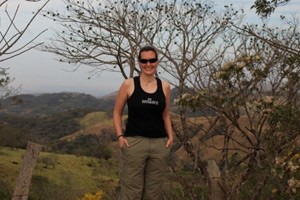
New UC Professor Uses the Past to See the Future
Madagascar, an isolated island off the southeast coast of Africa, is home to plant and animal species that are wild, wonderful and even slightly bizarre. New
Assistant Professor Brooke Crowley has spent time over the past six years studying the ecological history of Madagascar in the hope of determining the islands ecological future.
The animals and plants there are really unique and isolatedwhen I go there it feels like Im entering a Dr. Seuss world. Theres a tremendous diversity of species ranging from chameleons and lizards to butterflies to orchids and even primates, like the lemurswhich I really enjoyed studying, Crowley says. What Ive been doing is thinking about whats lived there in the last 10,000 years and how things changed when people came: what have been the responses to human impact; what is going on with animals living there today; what will their future be like; and what can we learn from the past to understand the current and future situation there.
As a quaternary paleo ecologist, Crowley mainly focuses on recent historywhich is actually considered the past 2.5 million years, though she mostly looks at a slightly more recent period, the Holocene, which spans the past 12,000 years.
To determine the history of past species, Crowley uses two techniques: radiocarbon dating and stable isotope ecology. Radiocarbon dating is used to figure out ages of extinct species and when they tapered off, while stable isotope ecology provides insight on the environmental conditions and dietary categories of animals. These techniques let Crowley create a long-term historical profile of extinct and living species which then allows her to take that information and paint a picture of the future.
I was able to radiocarbon date a bunch of bones from extinct and living animals, and Ive found theres a very clear pattern of when these species disappearedabout 1,000 years agowhich is right around the time of an increase in human activity. Thats component number one, she says. Component number two is how have the current species been affected by those extinctions: have there been ecological changes; are they eating different things or living in different habitats than they did in the past.
By understanding how things may have changed over time, Crowley can take that information and determine what long-term strategies make sense when thinking about the future. What is the biggest threat to animals today: is it forest loss; is it human hunting; is it that theyre being protected in a different habitat than what they should be; or is it something else we don't know yet?

Crowley enjoys some time with a lemur, a species native to Madagascar. (Inset) A ringtailed lemur.
Besides Madagascar, Crowley is also interested in using these techniques locally. One of her goals is to work in local places like Big Bone Lick State Park in Northern Kentucky and use local resources such as the Cincinnati Museum Center. Big Bone Lick is an interesting fossil locality where I could work as part of a team to find answers to some paleo ecological questions. Its an exciting place with great historical significance.
The mix of global and local research fits nicely with Crowleys outlook as she considers herself to be interdisciplinary by nature. Im an interdisciplinary-type person and Ive had trouble narrowing myself into a specific discipline. Fortunately, my position here is explicitly interdisciplinary and Im basically 50-50 in geology and anthropology.
She is currently in the process of developing several courses that will span both the Department of Geology and the Department of Anthropology. One graduate level course is a paleo-ecology seminar that will focus on the taxonomy of mammals in the United States and another will be in zoo archaeology, a foundational course that she is excited to bring to UC. She will also be teaching an introductory undergraduate course on environmental geology this spring. We will look at human impact and the historical ways we understand nature, biology and natural systems and then think about our roles todayin terms of consumables, waste and projections for the future of the natural world.
Through her courses and research experience, Crowley hopes to impart her interdisciplinary spirit on future students, too. Since theres no way I could really force myself into a specific discipline, the fact that my position is interdisciplinary has allowed me to develop a range of broad interestssomething I want my students to have.
Having other McMicken College of Arts and Sciences faculty that share a broad spectrum of interests has also helped Crowleys transition to UC. My colleagues are fantastic in both departments and its been a really welcoming experience. That was one of the things that sold me on UC. Even after my first meeting I immediately realized how much I enjoyed talking with everyone and I knew it was going to be fun.
Related Stories
From literature to AI: UC grad shares career path to success
April 23, 2024
Before Katie Trauth Taylor worked with international organizations like NASA, Boeing and Hershey, and before receiving accolades for her work in the generative AI space, she was in a much different industry: English and literature.
WVXU: Why is part of Green Township called Dent?
April 23, 2024
UC College of Arts and Sciences professor tells WVXU that Ohio's glacial past might explain how Dent got its name.
Local 12: Local universities open Taylor Swift courses
April 22, 2024
In the lead up to the release of Taylor Swift's new album, "The Tortured Poets Department," several media outlets covered classes offered at UC that focus on the singer's music and poetry. UC offers three classes that cover the pop icon: a general music course at CCM and two classes at A&S.
